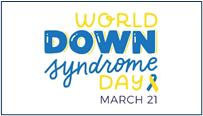
On March 21st the global population united to celebrate World Down Syndrome Day. Following up from this significant day of observance, it’s important to take the time to understand what Down syndrome is and how exceptional these individuals are.
Estimates by the Centers for Disease Control and Prevention say that one in every 700 babies in the United States is born with Down syndrome, which makes Down syndrome the most common chromosomal condition. About 6,000 babies are born with Down syndrome in the United States annually. For many years, people with Down syndrome have been represented in art, literature and science. However, it was not until the late nineteenth century that John Langdon Down, an English physician, formulated an accurate description of a person with Down syndrome. While other people recognized the syndrome, it was Down who accurately described the syndrome as a distinct entity. This revolutionary work, published in 1866, earned Down the name “father of the syndrome.”
Many people know the characteristics of the syndrome but not the science behind it. There is a nucleus, where genetic material is stored, in every cell of the human body. The codes responsible for all our hereditary traits are stored in genetic material along rod-like structures called chromosomes. Most of the time, the nucleus of each cell contains 23 pairs of chromosomes from each parent to total to 46 chromosomes. Individuals with Down syndrome have a full or partial copy of chromosome 21. Because of this additional genetic material, the individual’s development is altered, and that causes characteristics seen in people with Down syndrome. The common physical traits associated with Down syndrome are “low muscle tone, small stature, an upward slant to the eyes, and single deep crease across the center of the palm.” With that being said, each person with Down syndrome has unique, individual characteristics and might possess these physical traits in different ways or not at all. (Source: CDC)
Although there are multiple types of Down syndrome, all people with the syndrome have an extra part in a critical portion of chromosome 21 present in all or some of their body’s cells. The cause of this alteration in a cell’s chromosomes is still unknown. Maternal age is currently the only factor linked to an increased chance of having a baby with Down syndrome resulting from any of the chromosomal changes that lead to Down syndrome. However, even though older mothers have a higher chance of giving birth to a child with Down syndrome, 80% of children with Down syndrome are born to women under 35 years of age because of the high birth rates in younger women. There is currently no definitive scientific research indicating that the syndrome is caused by environmental factors or the parents’ activities before or during the pregnancy period. The altered part of the 21st chromosome which causes Down syndrome can be traced back to either the father or the mother. About 5% of the syndrome’s cases have been traced to the father. (Source: CDC)
With all that in mind, what is the likelihood of having a child with Down syndrome? The syndrome is seen in people of all races and economic statuses, so the only factor increasing the likelihood of a newborn with Down syndrome is the mother’s age. The National Down Syndrome Society’s website states that, “A 35-year-old woman has about a one in 350 chance of conceiving a child with Down syndrome, and this chance increases gradually to 1 in 100 by age 40. At age 45, the incidence becomes approximately 1 in 30.”
Unfortunately, very often when people all over the world are told that they are having or have given birth to a child with Down syndrome, words such as “I’m so sorry” are the first thing they hear. Sadly, there is an ignorance presented today against those with Down syndrome and a level of discrimination that so many individuals with Down syndrome endure every day, but why is this, and how can we convert to a more celebratory community, embracing these exceptional human beings? The Canadian Down Syndrome Society created an entire campaign centered around taking “sorry” out of one’s vocabulary in their #AnythingButSorry campaign recommending replacing the word “sorry” with words such as “congratulations” instead when addressing parents of infants and children with Down syndrome (Source: Today's Parent).
Hopefully, as scientific research progresses, we can learn so much more about Down syndrome. On March 21st, World Down Syndrome Day, these amazing individuals are celebrated, but it is important that we continually advocate for their rights and for more research and awareness about the syndrome not just on this day, but every day.
Sources:
Andrea Karr November 29, 2019. (2019, November 29). FAQ: How to welcome a baby with down syndrome. Today's Parent. Retrieved June 18, 2022, from https://www.todaysparent.com/baby/baby-health/down-syndrome-baby-faq/
Canadian down syndrome society (CDSS). English. (n.d.). Retrieved June 18, 2022, from https://cdss.ca/
Centers for Disease Control and Prevention. (2021, April 6). Facts about down syndrome. Centers for Disease Control and Prevention. Retrieved June 18, 2022, from https://www.cdc.gov/ncbddd/birthdefects/downsyndrome.html
Home. World Down Syndrome Day. (2022, June 8). Retrieved June 18, 2022, fromhttps://www.worlddownsyndromeday.org/
What is Down Syndrome?: National down syndrome society. NDSS. (2022, May 20). Retrieved June 18, 2022, from https://www.ndss.org/about-down-syndrome/down-syndrome/


